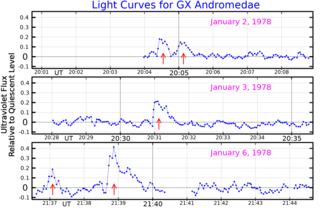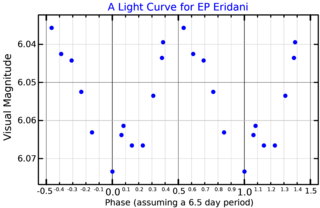Gliese 710, or HIP 89825, is an orange 0.6 M☉ star in the constellation Serpens Cauda. It is projected to pass near the Sun in about 1.29 million years at a predicted minimum distance of 0.051 parsecs—0.1663 light-years – about 1/25th of the current distance to Proxima Centauri. Such a distance would make for a similar brightness to the brightest planets, optimally reaching an apparent visual magnitude of about −2.7. The star's proper motion will peak around one arcminute per year, a rate of apparent motion that would be noticeable over a human lifespan. This is a timeframe, based on data from Gaia DR3, well within the parameters of current models which cover the next 15 million years.

Groombridge 34 is a binary star system in the northern constellation of Andromeda. It was listed as entry number 34 in A Catalogue of Circumpolar Stars, published posthumously in 1838 by British astronomer Stephen Groombridge. Based upon parallax measurements taken by the Gaia spacecraft, the system is located about 11.6 light-years from the Sun. This positions the pair among the nearest stars to the Solar System.

9 Aurigae is a star system in Auriga (constellation). It has an apparent magnitude of about 5, making it visible to the naked eye in many suburban skies. Parallax estimates made by the Hipparcos spacecraft put it at about 86 light-years from the solar system, although individual Gaia Data Release 3 parallaxes place all three components at 88 light years.
HD 211415 is a double star in the constellation Grus. With an apparent visual magnitude of 5.33, it is visible to the naked eye. The annual parallax shift is 72.54 mas, which yields a distance estimate of 45 light years. It has a relatively high proper motion, traversing the celestial sphere at the rate of 93.4 mas per year, and is moving closer to the Sun with a radial velocity of −13 km/s.

Gliese 105 is a triple star system in the constellation of Cetus. It is located relatively near the Sun at a distance of 23.6 light-years. Despite this, even the brightest component is barely visible with the unaided eye (see Bortle scale). No planets have yet been detected around any of the stars in this system.
HD 4628 is a main sequence star in the equatorial constellation of Pisces. It has a spectral classification of K2.5 V and an effective temperature of 5,055 K, giving it an orange-red hue with a slightly smaller mass and girth than the Sun. HD 4628 lies at a distance of approximately 24.3 light years from the Sun based on parallax. The apparent magnitude of 5.7 is just sufficient for this star to be viewed with the unaided eye. The star appears to be slightly older than the Sun—approximately 5.4 billion years in age. The surface activity is low and, based upon the detection of UV emission, it may have a relatively cool corona with a temperature of one million K.
Gliese 673 is an orange dwarf star in the constellation Ophiuchus. It has a stellar classification of K7V. Main sequence stars with this spectra have a mass in the range of 60–70% of solar mass (M☉).

HR 511 is an orange dwarf of spectral type K0V in the constellation Cassiopeia. With an apparent magnitude of 5.63, it is faintly visible to the naked eye. The star is relatively close, 32.8 light years from the Sun.

Psi Capricorni, Latinized from ψ Capricorni, is a single star in the southern zodiac constellation of Capricornus. It is a yellow-white hued star that is faintly visible to the naked eye with an apparent visual magnitude of +4.13. The distance to this star is approximately 47.9 light years based on parallax measurements, and it is drifting further away with a radial velocity of +20 km/s. The closest approach to the Sun occurred some 467,000 years ago at a separation of 20 light-years.

HD 17925 is a variable star in the equatorial constellation of Eridanus. It has the Gould designation 32 G. Eridani and the variable star designation EP Eri. The star has a yellow-orange hue and is dimly visible to the naked eye in good seeing conditions with an apparent visual magnitude that varies from 6.03 down to 6.08. It is located nearby at a distance of 34 light years from the Sun based on parallax, and is drifting further away with a radial velocity of +18 km/s. It is a likely member of the Local Association of nearby, co-moving stars. The spectrum shows a strong abundance of lithium, indicating that it is young star. This likely makes its point of origin the nearby Scorpio–Centaurus Complex.
HR 6806 or HD 166620 is a solitary, orange, main sequence, and Sun-like star located thirty-six light-years away, in the constellation Hercules. The star is smaller than the Sun, with around 79% of the solar mass and radius, and 35% of the solar luminosity. It appears to be rotating slowly with an estimated period of 42 days. In 1988, it was noticed that the star had an inactive chromosphere, with a surface magnetic field strength of only 1,500 G. From 1990 activity in the chromosphere increased, inline with a 16 year stellar cycle previously observed. But, sometime after 1994 chromospheric activity greatly reduced, and has stayed flat for more than 16 years. As of 2022, the star appears to have entered the equivalent of a Maunder minimum. The star is around six billion years of age.
Gliese 179 is a small red dwarf star with an exoplanetary companion in the equatorial constellation of Orion. It is much too faint to be visible to the naked eye with an apparent visual magnitude of 11.94. The system is located at a distance of 40.5 light-years from the Sun based on parallax measurements, but is drifting closer with a radial velocity of –9 km/s. It is a high proper motion star, traversing the celestial sphere at an angular rate of 0.370″·yr−1.
ADS 48 is a multiple star system in the constellation of Andromeda consisting of 7 stars. The components, in order from A to G, have apparent visual magnitudes of 8.826, 8.995, 13.30, 12.53, 11.68, 9.949, and 13.00.
Gliese 69 is a star located in the constellation of Cassiopeia. It has an apparent magnitude of 8.40. Parallax measurements by Hipparcos put it at a distance of 44.3 light-years away.
GJ 3323 is a nearby single star located in the equatorial constellation Eridanus, about 0.4° to the northwest of the naked eye star Psi Eridani. It is invisible to the naked eye with an apparent visual magnitude 12.20. Parallax measurements give a distance estimate of 17.5 light-years from the Sun. It is drifting further away with a radial velocity of +42.3 km/s. Roughly 104,000 years ago, the star is believed to have come to within 7.34 ± 0.16 light-years of the Solar System.
Gliese 880 is a red dwarf star in the northern constellation of Pegasus that may host an exoplanetary companion. No stellar companions to Gliese 880 have been discovered as of 2020.

GL Virginis, also known as G 12-30, is a star in the constellation of Virgo. It is a faint red dwarf, like more than 70% of the stars located within 10 parsecs of the Solar System; its magnitude visual magnitude is 13.898, making it impossible to see with the naked eye.
HD 126053 is the Henry Draper Catalogue designation for a star in the equatorial constellation of Virgo. It has an apparent magnitude of 6.25, which means it is faintly visible to the naked eye. According to the Bortle scale, it requires dark suburban or rural skies to view. Parallax measurements made by the Hipparcos spacecraft provide an estimated distance of 57 light years to this star. It is drifting closer with a heliocentric radial velocity of −19.2 km/s.

Gliese 15 Ac is an exoplanet orbiting the nearby red dwarf star Gliese 15 A, which is part of a binary star system located about 11.6 light-years from the Sun. The planet was first proposed in October 2017 using radial velocity data from the CARMENES spectrograph, combined with measurements from the HARPS and HIRES spectrographs, and its existence was confirmed in April 2018 using HARPS-N data. It has a minimum mass 36 times that of Earth and orbits at around 5.4 astronomical units with a period of 7,600 days, an orbit which may have been sculpted by interaction with the companion star, Gliese 15 B. As of 2020, Gliese 15 Ac is the longest-period sub-Jovian planet discovered by radial velocity.








